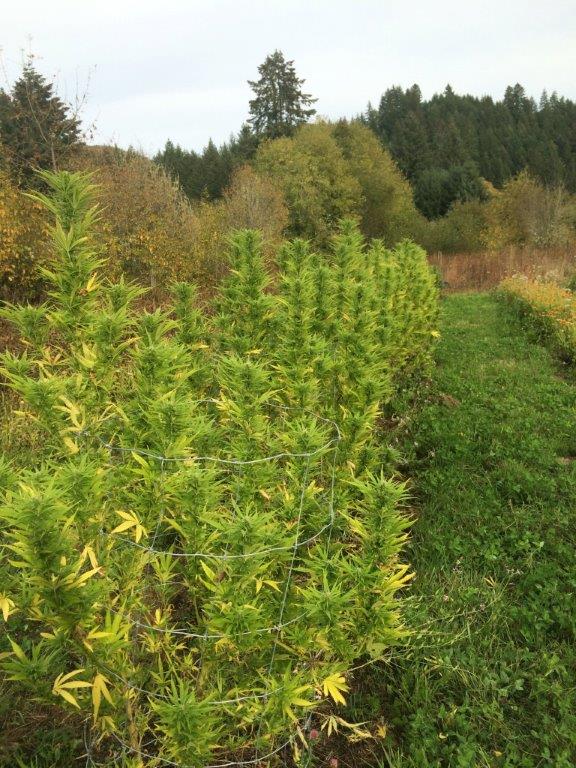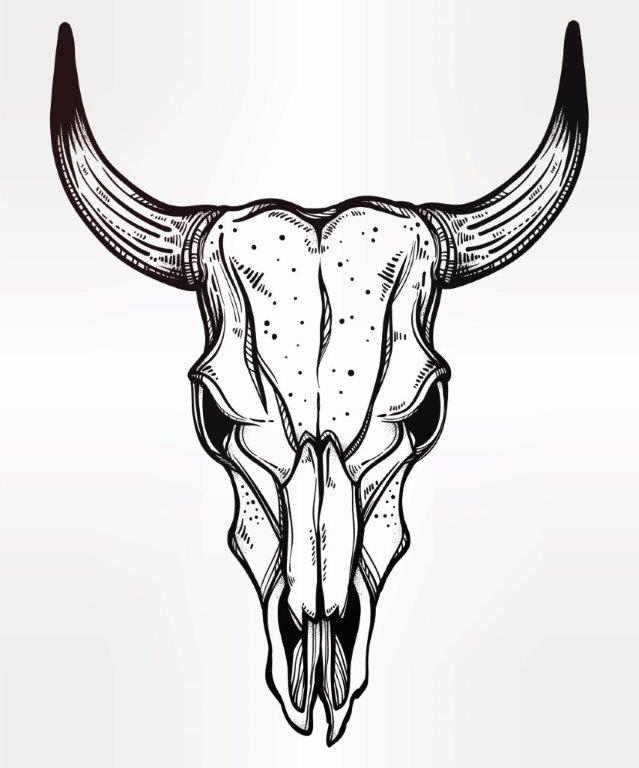
The biodynamic standards promoted by Demeter create farms with a more natural look that includes cover crops, livestock and cannabis, which is treated like any other crop, all sharing the same rustic environment. Photos courtesy Jim Fullmer.
Farmers looking to raise their crops without any chemical fertilizers or pesticides can follow the “organic” standards published by the federal government.
But while those guidelines can ensure a “chemical-free” crop, some farmers will say the results are still not “natural,” since organic standards focus on the materials used and not the process of farming itself.
That’s where biodynamics comes in, providing a framework for farmers seeking a more natural, eco-friendly style of agriculture, as well as providing a route to certification for cannabis growers unable to receive a federal “organic” stamp.
Developed in Europe in 1928, biodynamics treats the farm — and the planet — as a single organism, connected and intertwined with the quality of crops the land produces, instead of focusing on any single input.
“It’s not about the individual principle, it’s how they relate to each other,” says agronomist Jim Fullmer, executive director of Demeter Association, a nonprofit organization that certifies farms based on the principles of biodynamic agriculture. “The organism doesn’t stop at the fence line.”
The result, according to Fullmer, is healthier soil, better tasting crops (no matter what they are) and a stronger ecosystem.
“It’s about farming the Earth biologically and understanding there is a living continuum between the plants and the Earth,” he says. “The idea is that the farm operates as a living organism.”
The Biodynamic Preparations
Cow’s horns, stag bladders and the skull of a domestic animal contribute to a healthier soil
By Brian Beckley
One of the principles of biodynamic agriculture required for Demeter certification is the use of nine specific preparations utilized as field sprays and compost inoculants. According to Demeter, proper use of the preparations revitalize the soil, stimulate root growth, enhance the development of microorganisms and aid in photosynthesis.
Found in the Demeter Farm Standards Manual, the nine preparations are as follows:
– Pack as tightly as possible fresh cow manure from an animal residing on the farm into a raw cow horn and bury it 18-32 inches deep in a well-drained site with good soil and biological activity. The horns are to be buried in the fall and remain in the ground through the winter. Material removed from the horn must have completely transformed into a colloidal humus material. Apply at least annually to all harvested crops.
– Grind quartz, feldspar, orthoclase and other naturally occurring minerals of high silicon dioxide content into a fine, mealy powder and mix with water to the consistency of a thin dough. Place the mixture in a raw cow horn and bury the horn in the spring. Leave it in the ground through the summer. Store the finished product in a sunny location. Apply annually.
– Compress and enclose as completely as possible the complete head of a fresh yarrow flower (Achillea millefolium) in the bladder of a male deer or elk and tie it shut. Hang the bladder outside in the sunniest spot possible and leave it there through the summer. When autumn comes, bury it for the winter. In the spring, carefully remove only the blossoms that have spent a year in the bladder.
– Compress fresh chamomile blossoms into the intestines of a cow, creating “sausages” tied with untreated, natural ties. Make the sausages in the autumn and bury them in a rich soil mixture, leaving them buried through the winter. Carefully dig up in the spring. The chamomile blossoms should have transformed into a humus-like material.
– Gather stinging nettles, let them wilt slightly, compress them a bit and then bury in living top soil for a winter and the following summer. It must stay buried for a full year. When digging up, take caution to harvest only the buried nettles, which should have transformed into a dark, colloidal humus material. Store in a large vessel made of natural material that allows for the presence of oxygen.
– Chop crumbled oak bark into a crumb-like consistency and place in the brain cavity of a skull of a domesticated animal like a cow, pig or goat. Enclose the oak with a natural material such as bone, wood or clay. Bury the skull in a wet area where water can flow in and out and leave through the winter. In the spring, the bark should have transformed into humus.
– Place the dried, yellow heads of dandelion flowers into a bovine abdomen. Pack the blossoms together and sew the mesentery shut. Bury it in autumn and leave buried through the winter. Dig up in spring after the blossoms have transformed into an earthy-smelling humus.
– Ferment or juice the flowers of a valerian blossom to create a pungent, valerian juice to be sprayed on crops.
– Gather fresh or dried Equisetum arvense, or field horsetail, and create a tea to be used as a kind of liquid manure once brewed. Aim for a vibrant, green color and store as a dried herb for use when needed.
According to the standards, all preparations should be stored “in a location free of electromagnetic fields.” Many — but not all — of the preparations must be stored in a large vessel made of natural material that allows for the presence of oxygen.
Principles
The principles of biodynamics, a method of permaculture farming, are based around the natural ecosystem and the way plants interact with each other in it.
“You’re aiming to generate the inputs needed for farm management out of the living dynamics of the farm system itself, rather than importing from the outside in trucks or bottles,” Fullmer says. “It’s the same principles the natural world uses to be healthy.”
There are seven principles to biodynamics, which Fullmer describes as “regenerative-organic agriculture,” all laid out in Demeter’s 59-page “Farm Standards” manual. The first and most important principle is biodiversity. Demeter certification requires farmers to set aside at least 10% of their land as a “reservoir of beneficial life for the rest of the farm,” as Fullmer puts it. The land can be a preserved wild area or can be planted in order to provide food and habitat for insects and other animals that can aid fertilization and insect-control at a farm.
In addition, Demeter-certified farms must also produce fertility internally, generate their own pest control, conserve water, integrate livestock into the operation, use gentle post-harvest handling procedures and follows the nine biodynamic preparations (see sidebar) made from herbs, mineral substances and animal manures and utilized in field sprays and compost inoculants.
“These are the principles that are inherent to the Earth, literally,” Fullmer says.
Biodynamic farms are also required to rotate crops, with no annual crop planted in the same field for more than two years in succession. The result, according to the company, is a richer layer of humus, the dark organic matter created by decaying organisms, and healthier soil in general.
And better soil, claims the company, leads to a better product.
An Evolution
The movement’s roots can be traced back to Rudolf Steiner, who recognized a rapid decline in seed fertility, crop vitality and animal health, according to Demeter’s website. In response to the issues, Steiner hosted a series of lectures based around the idea of a farm as a living organism, which was something of a contrast to the modern agriculture methods of the industrial revolution.
“It’s the roots of organic. It’s the roots of sustainability,” Fullmer says. “It’s the roots of regenerative agriculture.”
Demeter was formed in Berlin in 1928 to codify Steiner’s principles into a series of standards that became the company’s certification criteria. The required biodynamic preparations, which include processes like burying a cow horn full of manure from a cow that lives on the farm, are also drawn directly from Steiner’s lectures.
“It’s not a new idea,” Fullmer says. “They are the original idea of organic.”
Though not designed for cannabis, Demeter began certifying cannabis farms in early 2016. Fullmer says there was a lot of interest in the group’s methods from cannabis farmers and the company views it no different from any other crop for its certification purposes.
“Why shouldn’t we?” Fullmer asks.
So far, only a handful of cannabis farms have been certified though because the standard is, admittedly, stricter than most of the other certification methods available. Among those making the grade are California’s HerbaBuena and Washington’s White Oak Woodland. Fullmer also grows biodynamic cannabis at the state-licensed Hoskins Berry Farm on the Oregon coast, along with industrial hemp and other crops. He still considers himself a “novice” when it comes to cannabis and says he just considers it another crop in his crop rotation, though he says despite leaving his crop in the rain, it had no mildew, no mold and tested higher in cannabinoids than other, non-biodynamic buds at a local dispensary.
Although the principles and methods of biodynamic agriculture are throwbacks to the era of pre-industrialized, traditional farming, Fullmer says this is actually an evolution of the industry, not an anachronism.
“Why does this matter? To me, the main reason is it holds the principles that are precious to humanity,” he says. “We’re not going backward. We’re going forward.”
This story was originally published in the November 2017 issue of Marijuana Venture, on sale now.
[contextly_auto_sidebar]


